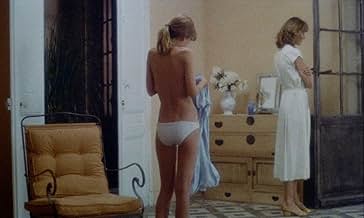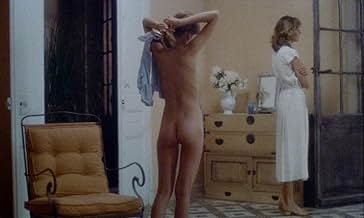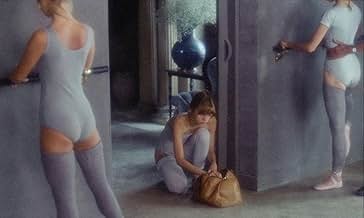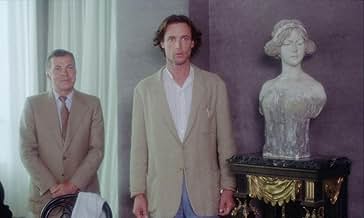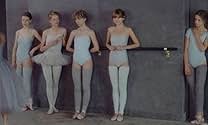Laura, les ombres de l'été
- 1979
- Tous publics
- 1h 35min
NOTE IMDb
5,6/10
1,6 k
MA NOTE
Un sculpteur est fasciné par Laura, la fille de Sara (son premier amour). Sara accepte qu'il sculpte Laura mais uniquement d'après photos. Devenu aveugle, Paul terminera son uvre en palpant ... Tout lireUn sculpteur est fasciné par Laura, la fille de Sara (son premier amour). Sara accepte qu'il sculpte Laura mais uniquement d'après photos. Devenu aveugle, Paul terminera son uvre en palpant la fillette désirée, qui s'offre à lui quinze ans après sa mère. [255]Un sculpteur est fasciné par Laura, la fille de Sara (son premier amour). Sara accepte qu'il sculpte Laura mais uniquement d'après photos. Devenu aveugle, Paul terminera son uvre en palpant la fillette désirée, qui s'offre à lui quinze ans après sa mère. [255]
- Réalisation
- Scénario
- Casting principal
William Milié
- Le chorégraphe
- (as William Millie)
Gunilla Astrom
- Diane
- (non crédité)
Bernard Daillencourt
- Docteur Benoît
- (non crédité)
David Hamilton
- Un invité à la réception
- (non crédité)
Patrick Juvet
- Pianiste
- (non crédité)
Katia Kofet
- Claudie
- (non crédité)
Luciano
- Timothez Sega
- (non crédité)
Michael Pochna
- Gérard
- (non crédité)
Anja Schüte
- Dancer
- (non crédité)
Avis à la une
I have read several technical critiques of this movie over the years, but it they all miss the mark for me, because this film provides something that very few films ever do - a gentle, poignant and tranquil approach into a world where the artistic, feminine and erotic merge in a manner that is generally well conceived and often breathtakingly beautiful.
David Hamilton is first and foremost a fine art photographer, and whilst there may be cinematic errors here, the visual content of the film allows one to pause and consider the wonder of the female form. I am delighted to own a copy of this visual hymn to some of the most delightful aspects of human life.
Howard Nowlan Fine Art Photographer, Cornwall, UK.
David Hamilton is first and foremost a fine art photographer, and whilst there may be cinematic errors here, the visual content of the film allows one to pause and consider the wonder of the female form. I am delighted to own a copy of this visual hymn to some of the most delightful aspects of human life.
Howard Nowlan Fine Art Photographer, Cornwall, UK.
Laura, Les Ombres De L'ete
David Hamilton does a great job expressing his seeming obsession with pre-pubescent ballet dancers in Laura, Les Ombres De L'ete. Possibly one of the worst (and most boring) "art house" pictures ever made, professional photographer/amateur filmmaker Hamilton drowns in his excessive use of soft focus, pseudo-artistic fadeouts, and nudity, devices employed to make up for the shallow plot.
After seeing teenaged Laura (Dawn Dunlap) at ballet class, sculptor Paul Thomas Wyler (James Mitchell) knows that he must sculpt this beautiful little girl, just as he had done with her mother Sarah (Maud Adams) 20 or so years prior. But Sarah can see through his superficial intentions and tries her best to keep her very curious daughter from posing for this oh-so-artistic womanizer.
Laura contains several sequences of excessive nudity (mostly of young Dunlap) and there is no doubt that Hamilton's subjects are quite attractive; in fact, the photo-shoot scenes, with Sarah taking endless pictures of her naked daugher prancing around (including a few gymnastic poses), are certainly provocative. But like Hamilton's other exploitative French productions, the story is built around these sequences and without them there is little else to interest the viewer. The film comes across as heavy-handed, pretentious, and, ultimately, empty. Some termed this soft-core when it was released but the film simply isn't graphic enough to qualify for the category. -- David Ross Smith
David Hamilton does a great job expressing his seeming obsession with pre-pubescent ballet dancers in Laura, Les Ombres De L'ete. Possibly one of the worst (and most boring) "art house" pictures ever made, professional photographer/amateur filmmaker Hamilton drowns in his excessive use of soft focus, pseudo-artistic fadeouts, and nudity, devices employed to make up for the shallow plot.
After seeing teenaged Laura (Dawn Dunlap) at ballet class, sculptor Paul Thomas Wyler (James Mitchell) knows that he must sculpt this beautiful little girl, just as he had done with her mother Sarah (Maud Adams) 20 or so years prior. But Sarah can see through his superficial intentions and tries her best to keep her very curious daughter from posing for this oh-so-artistic womanizer.
Laura contains several sequences of excessive nudity (mostly of young Dunlap) and there is no doubt that Hamilton's subjects are quite attractive; in fact, the photo-shoot scenes, with Sarah taking endless pictures of her naked daugher prancing around (including a few gymnastic poses), are certainly provocative. But like Hamilton's other exploitative French productions, the story is built around these sequences and without them there is little else to interest the viewer. The film comes across as heavy-handed, pretentious, and, ultimately, empty. Some termed this soft-core when it was released but the film simply isn't graphic enough to qualify for the category. -- David Ross Smith
I was 12 when this came out, saw it later in the 80s and currently picked up the dvd at a charity shop and watched it again as an old man lol. It was nice to see something you saw as a young man and look back and realize how simple yet complex being young was in those days, we were kids but thought we were adults at 15, (Dawn was 17 in real life) most of us were experimenting or well past at that age, or at least my crowd was. I remember a few girls in grade 8 that looked 18 that were carrying on with our gym teacher on lunch breaks in his van doing the cheech and chong and get naked routine, (yes Julie L I'm referring to you ha ha)
As far as the movie goes it was all over the place and though it didn't seem to be put together well, it made sense. Some people have commented why the mother sent pics but wouldn't allow him to see Laura, well she wanted him to remember her and tempt him back using Laura's beauty since her marriage was dead. She wanted him for herself until she realized he only loves illusions of women. That's why she wasn't angry at her daughter or Paul when she allowed the daughter to say goodbye to her "ballet friends" but saw him instead before being sent away to school or wherever, mom knew it would be good for her to close that chapter and Paul was innocent enough. Another comment was how did Paul just walk in the ballet class and not get questioned? Well his helper was in the class and invited him along to see the girls, simple. As far as the age gap, looking at it with North American eyes it may seem a little too much, but in France you can drink wine at 12, date older men and it's nothing to look twice at, I think it was a nice slice of coming of age and reminding us we were all nubile and young at one point, we never change totally, just grow older.
As far as the movie goes it was all over the place and though it didn't seem to be put together well, it made sense. Some people have commented why the mother sent pics but wouldn't allow him to see Laura, well she wanted him to remember her and tempt him back using Laura's beauty since her marriage was dead. She wanted him for herself until she realized he only loves illusions of women. That's why she wasn't angry at her daughter or Paul when she allowed the daughter to say goodbye to her "ballet friends" but saw him instead before being sent away to school or wherever, mom knew it would be good for her to close that chapter and Paul was innocent enough. Another comment was how did Paul just walk in the ballet class and not get questioned? Well his helper was in the class and invited him along to see the girls, simple. As far as the age gap, looking at it with North American eyes it may seem a little too much, but in France you can drink wine at 12, date older men and it's nothing to look twice at, I think it was a nice slice of coming of age and reminding us we were all nubile and young at one point, we never change totally, just grow older.
David Hamilton is so impressed with himself as a photographer, that he has convinced himself he can make a good film. Well, he's wrong. For example, I have a theory that he saw a good use of a fade out in a movie once and thought that if one fade out is good, then 75 of them must be great! Again, he's wrong. There is one sequence where Sarah (Maud Adams) is speaking to her daughter Laura (Dawn Dunlap) who is lying in bed. The camera shows Sarah talking and then slowly fades out to black only to shift to Laura in bed as she responded directly to her mother and continues the conversation. Maybe Hamilton felt this would make the dialogue have more resonance. Again, he's wrong. I've noticed that Hamilton is wrong a lot in this film. The movie fails on so many levels that I cannot begin to list them all here. All I can say is that you should avoid this movie at all costs. I give it a 1/10.
I agree more or less with all the comments sent so far. This might be surprising, because they seem to be so different. But they are sent from different points of view, and if you try to make a resume, you'll see how it all fits well. Let's make an example: "Glengarry Glen Ross" (or some similar indoor drama) can be described as perfect deep (by drama lovers) or terribly unwatchable slow boring movie (by action lovers); great example how a masterpiece can be made without a single female role (artistic purist statement), or a glorifying men in business and so neglecting women (a feminist statement) or even a pointless flick with no chicks to look at (a macho statement); a movie where authors bravely use words that people use in reality, or a blasphemy with an obscene language that would fit only in NC-17 movie.
I admire and adore Hamilton's work as a photograph. But, yes, being a genius in one art doesn't automatically mean you can make masterpieces in other arts (Barbara Streissand is an exemption). Some great movie photographers made movies (like Nykvist), but they learned job with people like Tarkovsky. Hamilton made only still pictures, and this is what he does best. I think making movies was not a bad idea, but he should have made them as a photographer and leave directing to a professional. Then he could have avoided some real mistakes described in earlier comments. But I wouldn't be too strict. If you don't expect too much his movies won't disappoint you. Of course, if you don't accept nudity, this is not a movie for you, but such audience knows they should avoid Hamilton's work in general. People who believe showing nude young bodies is a sin are entitled to their opinions; but if you believe such a movie could induce child molestation, you should also ban all crime movies, thrillers (not to mention horrors), movies where people smoke, eat fast food, hurt each other in any way, appear in dangerous situations (most adventure movies from Tom Sawyer and Tarzan to Indiana Jones) etc. - such behaving can also be imitated, even more dangerously (there is no violence in Hamilton's movies!). And a man who can't tell reality from a movie is a psychopath who will cross the line of crime sooner or later regardless the movies he watches.
Back to Laura and Hamilton. In Laura he made probably his most beautiful scenes, like Laura going out from the sea, and the opening sequences are his typical. And the scene some don't like, some find controversial, when Laura dances and her mother takes pictures, is a real homage to photography as art. It is an artist-model and not a mother-daughter relation. With a photo (or pencil, or canvas) in his hand an artist leaves his real world, stops being a member of family, race, nation, he creates a new world. Here Hamilton gives us a short lesson of making photos, feeling the light (Hamilton's strongest tool), lines, movements. If a picture paints a thousand words this scene saves a million words if you want to make a documentary about Hamilton himself. And this is where I agree with some of earlier comments, his work talks enough, he should stay behind camera. No words. Less directing.
A film, though with weak script and much too big oscillations in directing, was saved by great acting and again (like in Bilitis) by perfect music. For Hamilton fans - don't expect "La Dance" or "Dreams of a Young Girl", but you'll like it. The others, if not too easily offended, probably won't turn the TV off, but it's also very likely they won't remember it too long.
I admire and adore Hamilton's work as a photograph. But, yes, being a genius in one art doesn't automatically mean you can make masterpieces in other arts (Barbara Streissand is an exemption). Some great movie photographers made movies (like Nykvist), but they learned job with people like Tarkovsky. Hamilton made only still pictures, and this is what he does best. I think making movies was not a bad idea, but he should have made them as a photographer and leave directing to a professional. Then he could have avoided some real mistakes described in earlier comments. But I wouldn't be too strict. If you don't expect too much his movies won't disappoint you. Of course, if you don't accept nudity, this is not a movie for you, but such audience knows they should avoid Hamilton's work in general. People who believe showing nude young bodies is a sin are entitled to their opinions; but if you believe such a movie could induce child molestation, you should also ban all crime movies, thrillers (not to mention horrors), movies where people smoke, eat fast food, hurt each other in any way, appear in dangerous situations (most adventure movies from Tom Sawyer and Tarzan to Indiana Jones) etc. - such behaving can also be imitated, even more dangerously (there is no violence in Hamilton's movies!). And a man who can't tell reality from a movie is a psychopath who will cross the line of crime sooner or later regardless the movies he watches.
Back to Laura and Hamilton. In Laura he made probably his most beautiful scenes, like Laura going out from the sea, and the opening sequences are his typical. And the scene some don't like, some find controversial, when Laura dances and her mother takes pictures, is a real homage to photography as art. It is an artist-model and not a mother-daughter relation. With a photo (or pencil, or canvas) in his hand an artist leaves his real world, stops being a member of family, race, nation, he creates a new world. Here Hamilton gives us a short lesson of making photos, feeling the light (Hamilton's strongest tool), lines, movements. If a picture paints a thousand words this scene saves a million words if you want to make a documentary about Hamilton himself. And this is where I agree with some of earlier comments, his work talks enough, he should stay behind camera. No words. Less directing.
A film, though with weak script and much too big oscillations in directing, was saved by great acting and again (like in Bilitis) by perfect music. For Hamilton fans - don't expect "La Dance" or "Dreams of a Young Girl", but you'll like it. The others, if not too easily offended, probably won't turn the TV off, but it's also very likely they won't remember it too long.
Le saviez-vous
- AnecdotesWhen Laura is in the ballet shower, many of the poses duplicate paintings of Edgar Degas (an artist famed for his ballerina portraits).
- Versions alternativesThe German cut is ten minutes shorter than the regular version at 85 mins.
Meilleurs choix
Connectez-vous pour évaluer et suivre la liste de favoris afin de recevoir des recommandations personnalisées
- How long is Laura?Alimenté par Alexa
Détails
Contribuer à cette page
Suggérer une modification ou ajouter du contenu manquant

